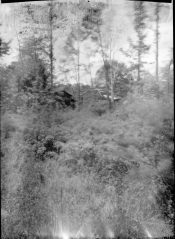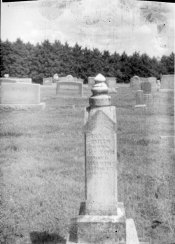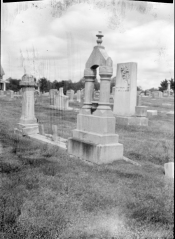Donald Qualls
Subscriber
This starts with a life change that took me away from photography and my improvised darkroom for a while. In fact, three life changes, that kept me from shooting film, lens or pinhole, or developing, or printing, for more than twelve years.
Now, when things changed the first time, all my photography stuff was in "I'll be back at this tomorrow" condition -- cameras loaded, batteries in flash units, chemicals in jars and bottles, etc. And then there it all sat.
Among other things, I had a couple jars of Dektol stock solution that I'd mixed at double strength (mostly because I didn't have enough containers to store five gallons of stock, as well as in the hope it'd keep long enough to use most of it). I had already-expired (1998) Tri-X Professional 320 sheet film (9x12 cm) loaded in plate holders for my Ideal plate cameras. I had three one gallon size bottles of Kodak Rapid Fixer concentrate (already old when I acquired it, but not marked with expiration), a couple bottles of working solution stop bath -- well, I had a bunch of stuff, but this is what's relevant to today.
This year, on World Pinhole Photography Day in April, I'd just barely mixed a quart of Cinestill Df96 monobath, and processed two rolls in it -- I was close to getting the construction work done to close in and plumb my darkroom. So, I went out (far from anyplace with people -- it was, after all, the height of the "Stay Home" order) with my Ideal and four plate holders loaded with (by now) 22 year expired Tri-X 320 and the pinhole lens mounted on the camera. I quickly found one of the plate holders was misloaded -- the film sheath was loose behind the dark slide, and the slide jammed when I tried to reinsert it.
The other three, however, I exposed at metered exposure, box speed, without making any compensation for reciprocity departure (did I mention I'd been away from photography for a dozen years?) or the age of the film (stored at room temperature for as long as I've had it). Then the contractor came to make a minor floor repair in the kitchen, which turned into tearing out most of the kitchen subfloor and about half the living room, replacing the cabinets and sink -- with the result that my darkroom work was delayed a week.
At the end of that work, my darkroom space was filled with stuff that had been displaced from the living room and my partner's office space (which had been my camera storage and radio shack).
Well, today, I got the darkroom straightened out enough to develop film. Since the pinhole sheets were already in the Yankee Agitank, they were up first: but that tank wants 48 ounces to develop up to 12 sheets of 9x12, and the Df96 was only a quart. I had planned to mix a second quart of Df96, combine the two, and carry the processing count for the pair (two rolls would require one roll of time correction in the larger volume).
By the time I got things to where I could develop, however, I found it was too late in the day to mix the Df96 in "warm" water (around 100F) and still cool it to 80F or so for processing; plus, I couldn't find either my stirring paddles or my darkroom thermometer (they're here somewhere, I just haven't emptied that box yet). Well, I knew where I had a bottle of that Dektol double strength stock solution, and it was still the same color it had been when I last used it. I knew where there was fixer concentrate, and I could see the stop bath was still yellow in its translucent storage bottle -- indicating it was acidic enough to stop development.
Well, then, here we go. Nope, no hints on the Internet for how long to process long-expired TXP in antique Dektol (not very surprising), but I found a very old thread on Large Format Forum suggesting that 5-6 minutes at the standard 1+9 film dilution was a good starting point for that film -- twenty years ago, anyway.
Okay, starting from liquids, I could mix with cool water. I don't know what the temperature was, but it was below 75F, and above 65F (I tempered cold tap water with a trickle of our lackluster hot, and I know what 75F feels like from my partner's aquarium). I set up DevIt! on my phone for 6:30, clip tested both the developer and the fixer (both worked) -- nothing more to do than start.
Hint: don't develop with chemicals in 2L soda bottles.
Oh, the bottles are fine, they do a pretty good job of keeping oxygen out of your chemistry, and you can squeeze them easily to eliminated the air inside. They are not, however, capable of pouring a lot of liquid rapidly.
Yet, when you process film that expired when most of the new generation of film photographers were in diapers, with developer that was mixed fifteen years ago, if the only complaint you can make is over the hesitation marks from the slow fill -- I'd say you've come out pretty well.
Do I recommend doing things this way? Go back and read the title. Does it work? Seemingly it does, at least if you have the blessing of the Great Yellow Father. Worth noting that every chemical and material I used for this was made in Rochester, before Kodak even moved their coating facility to Colorado, never mind started outsourcing their chemicals.
I feel blessed, and satisfied.
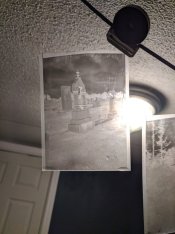
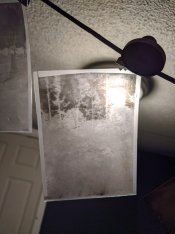
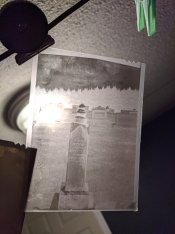
Now, when things changed the first time, all my photography stuff was in "I'll be back at this tomorrow" condition -- cameras loaded, batteries in flash units, chemicals in jars and bottles, etc. And then there it all sat.
Among other things, I had a couple jars of Dektol stock solution that I'd mixed at double strength (mostly because I didn't have enough containers to store five gallons of stock, as well as in the hope it'd keep long enough to use most of it). I had already-expired (1998) Tri-X Professional 320 sheet film (9x12 cm) loaded in plate holders for my Ideal plate cameras. I had three one gallon size bottles of Kodak Rapid Fixer concentrate (already old when I acquired it, but not marked with expiration), a couple bottles of working solution stop bath -- well, I had a bunch of stuff, but this is what's relevant to today.
This year, on World Pinhole Photography Day in April, I'd just barely mixed a quart of Cinestill Df96 monobath, and processed two rolls in it -- I was close to getting the construction work done to close in and plumb my darkroom. So, I went out (far from anyplace with people -- it was, after all, the height of the "Stay Home" order) with my Ideal and four plate holders loaded with (by now) 22 year expired Tri-X 320 and the pinhole lens mounted on the camera. I quickly found one of the plate holders was misloaded -- the film sheath was loose behind the dark slide, and the slide jammed when I tried to reinsert it.
The other three, however, I exposed at metered exposure, box speed, without making any compensation for reciprocity departure (did I mention I'd been away from photography for a dozen years?) or the age of the film (stored at room temperature for as long as I've had it). Then the contractor came to make a minor floor repair in the kitchen, which turned into tearing out most of the kitchen subfloor and about half the living room, replacing the cabinets and sink -- with the result that my darkroom work was delayed a week.
At the end of that work, my darkroom space was filled with stuff that had been displaced from the living room and my partner's office space (which had been my camera storage and radio shack).
Well, today, I got the darkroom straightened out enough to develop film. Since the pinhole sheets were already in the Yankee Agitank, they were up first: but that tank wants 48 ounces to develop up to 12 sheets of 9x12, and the Df96 was only a quart. I had planned to mix a second quart of Df96, combine the two, and carry the processing count for the pair (two rolls would require one roll of time correction in the larger volume).
By the time I got things to where I could develop, however, I found it was too late in the day to mix the Df96 in "warm" water (around 100F) and still cool it to 80F or so for processing; plus, I couldn't find either my stirring paddles or my darkroom thermometer (they're here somewhere, I just haven't emptied that box yet). Well, I knew where I had a bottle of that Dektol double strength stock solution, and it was still the same color it had been when I last used it. I knew where there was fixer concentrate, and I could see the stop bath was still yellow in its translucent storage bottle -- indicating it was acidic enough to stop development.
Well, then, here we go. Nope, no hints on the Internet for how long to process long-expired TXP in antique Dektol (not very surprising), but I found a very old thread on Large Format Forum suggesting that 5-6 minutes at the standard 1+9 film dilution was a good starting point for that film -- twenty years ago, anyway.
Okay, starting from liquids, I could mix with cool water. I don't know what the temperature was, but it was below 75F, and above 65F (I tempered cold tap water with a trickle of our lackluster hot, and I know what 75F feels like from my partner's aquarium). I set up DevIt! on my phone for 6:30, clip tested both the developer and the fixer (both worked) -- nothing more to do than start.
Hint: don't develop with chemicals in 2L soda bottles.
Oh, the bottles are fine, they do a pretty good job of keeping oxygen out of your chemistry, and you can squeeze them easily to eliminated the air inside. They are not, however, capable of pouring a lot of liquid rapidly.
Yet, when you process film that expired when most of the new generation of film photographers were in diapers, with developer that was mixed fifteen years ago, if the only complaint you can make is over the hesitation marks from the slow fill -- I'd say you've come out pretty well.
Do I recommend doing things this way? Go back and read the title. Does it work? Seemingly it does, at least if you have the blessing of the Great Yellow Father. Worth noting that every chemical and material I used for this was made in Rochester, before Kodak even moved their coating facility to Colorado, never mind started outsourcing their chemicals.
I feel blessed, and satisfied.








